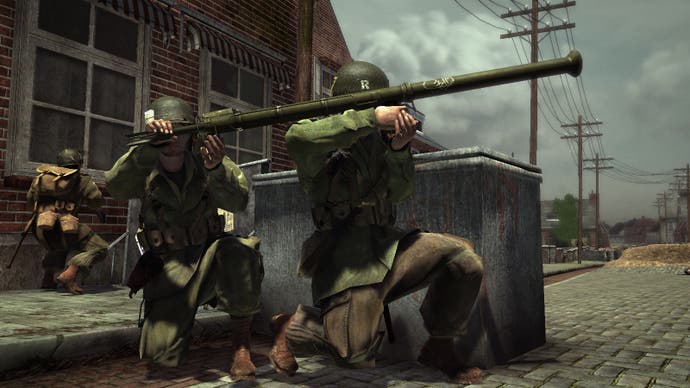Brothers in Arms: Hell's Highway
Middle of the road.
Brothers In Arms' first appearance in early 2005 was a shot in the arm for the battle-weary World War II genre. By putting a first-person spin on Full Spectrum Warrior's excellent 'cover and suppress' gameplay, it helped steer the genre in a more intelligent, strategic direction. Within each level were, essentially, a bunch of set-piece puzzles to solve: you'd face clusters of entrenched enemies and have to try and suss out ways in which to pick them off through cunning squad placement, and a mixture of suppression and flanking tactics. Running headlong towards the enemy was a one-way ticket to death.
This strategy-lite was hugely satisfying, but, by necessity, slowed the pace down to a crawl compared to the more cinematically-minded and gung-ho shooters. This amped up the tension, and made the action feel more like a gritty war of attrition than one man's Rambo charge down a corridor. Dialling down of the run-and-gun aspect meant there was generally a better sense of squad unity, and Gearbox took full advantage by zoning in on the trials that individual characters faced, as well as a greater emphasis on authentically recreating the real-life settings.
It wasn't for everyone, evidently, and was a little repetitive over the whole campaign - even more so if you happened to play the quick-fire sequel, Earned In Blood, which came out just seven months later. That we've had to wait almost three years for the third in the series is definitely a Good Thing in our book. Putting the franchise out to pasture for a while (by accident or design - you choose) has, in theory, given Gearbox ample time in which to reinvigorate the brand and build on the many good ideas, while giving fans a chance to recharge their enthusiasm for another merry round of Axis slaughter.

On paper, you can't argue with all the new features. The 'Big Thing' for Hell's Highway is without doubt destructible cover. It's not simply about suppressing the enemy anymore, it's about identifying weaknesses in their cover points and taking maximum advantage. If your enemy is behind a metal barricade, tough luck, but if they're stupid enough to think that a rickety wooden fence or a pile of sandbags are going to provide adequate cover, tell the men with bazookas to rain death down upon it and see just how long it lasts.
With this extra layer of strategy built in to the game, it's no longer a case of getting your squad to suppress while you merrily outflank them. It's evident right from the word go that Gearbox has expanded the battlefields sufficiently that you're almost always outnumbered. While you might have two or three squadrons of men to position around the environment, the chances are you'll be facing maybe five or six pockets of enemies. You really have to consider your priorities a lot more. Generally, you might figure out the weak links first, destroy their cover, pick off the stragglers, and then when the odds have been evened out, suppress the enemies which give you, Sgt. Matt Baker, the chance to slip in down the flanks and pick enemies off when you've got an appropriate angle.

Initially, at least, directing the battlefield via the joypad feels a little counterintuitive with the default control mapping. Little things trip you up, like the way that aiming down your sights is mapped to a click on the right stick, rather than on the left trigger like you expect. But with a little persistence, it's easy to see why Gearbox chose to do so, with the emphasis on making the squad management system as easy as possible. If it really bothers you, however, there are a further four control mappings available - one of which (amusingly called Tour of Duty) allows you to use the left trigger/L2 to use the line-of-sight/zoom function. In common with Ubi-published military titles like Rainbow Six and GRAW, issuing squad commands is simple and intuitive. You hold down the left trigger to bring up a circular indicator and guide it with the left stick over the enemy to issue an attack order, or to a cover point to get them to move. Actions are frequently context-sensitive, so if it's possible for your squad to lob a grenade, the icon will change on the fly to reflect that. Likewise, if you have a bazooka squad and can feasibly destroy their cover, you'll see immediately if it's possible. Issuing the order is as simple as letting go of the left trigger.
If, however, you want to cancel the order, pressing the right trigger gets rid of the order reticule entirely. It takes a bit of getting used to, and you'll frequently issue orders in error (usually by ham-fistedly hitting the left trigger and sending your men blindly off into a hail of hot lead), but once you re-wire your gaming habits, it's a decent system which works well on the pad. With further options to switch between squad types (such as assault and bazooka teams), and an option for one or all of your teams to fall-in behind you, it's flexible without ever feeling overly convoluted.
At its core, the gameplay remains largely unaltered. It's still very much a case of training suppression fire in the right places, and keeping a close eye on the pie-chart indicators that appear above the heads of each group of enemy. The more red that appears in the pie-chart, the less suppressed they are, and hence the more dangerous they become. If the circle is entirely blue, however, it's possible to run towards them in almost complete safety.


